Showing Spotlights 65 - 72 of 235 in category All (newest first):
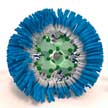 Due to their fascinating optoelectronic properties, halide perovskites have attracted tremendous research interest as promising materials for photovoltaics, photodetectors, LEDs, and lasers. Researchers report report a strategy to synthesize perovskite nanocrystals using diblock copolymer micelles as a growth template. This work constitutes a new approach for synthesizing perovskite nanocrystals of controllable size and composition with vastly improved resistance to halide ion migration and environmentally induced degradation.
Due to their fascinating optoelectronic properties, halide perovskites have attracted tremendous research interest as promising materials for photovoltaics, photodetectors, LEDs, and lasers. Researchers report report a strategy to synthesize perovskite nanocrystals using diblock copolymer micelles as a growth template. This work constitutes a new approach for synthesizing perovskite nanocrystals of controllable size and composition with vastly improved resistance to halide ion migration and environmentally induced degradation.
Aug 7th, 2019
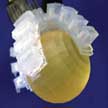 Electronic skin (e-skin) technology will give prosthetics and soft robotics a finer sense of touch, of what's hard and soft, hot and cold, smooth and rough. Researchers have now demonstrated a soft robotic hand integrated with four tactile force sensors and one temperature sensor to give it similar sensitivity to a human hand. By integrating an e-skin, the tactile pressure to grab an object and the friction movement of an object from the hand can be monitored. Thanks to the arrangement of multiple tactile sensors, e-skin-integrated soft robotic hand also can monitor sliding of an object by detecting the time delay of the tactile force.
Electronic skin (e-skin) technology will give prosthetics and soft robotics a finer sense of touch, of what's hard and soft, hot and cold, smooth and rough. Researchers have now demonstrated a soft robotic hand integrated with four tactile force sensors and one temperature sensor to give it similar sensitivity to a human hand. By integrating an e-skin, the tactile pressure to grab an object and the friction movement of an object from the hand can be monitored. Thanks to the arrangement of multiple tactile sensors, e-skin-integrated soft robotic hand also can monitor sliding of an object by detecting the time delay of the tactile force.
Jun 20th, 2019
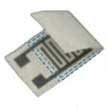 Recently, a brand-new mechanism of pressure sensing, known as flexible iontronic sensing (FITS), has been introduced, which utilizes pressure-induced capacitive changes between electrodes and ionic surfaces. Researchers have used FITS to develop a single-sheet iontronic paper substrate with both ionic and conductive patterns as an all-in-one flexible sensing platform. This novel paper sensor extends the iontronic sensing principle to a more adaptive material system, with direct printability, custom cuttability, and 3D foldability at a low cost - just as regular paper.
Recently, a brand-new mechanism of pressure sensing, known as flexible iontronic sensing (FITS), has been introduced, which utilizes pressure-induced capacitive changes between electrodes and ionic surfaces. Researchers have used FITS to develop a single-sheet iontronic paper substrate with both ionic and conductive patterns as an all-in-one flexible sensing platform. This novel paper sensor extends the iontronic sensing principle to a more adaptive material system, with direct printability, custom cuttability, and 3D foldability at a low cost - just as regular paper.
Mar 27th, 2019
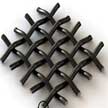 Motivated by the high level of flexibility exhibited by spider webs, scientists have developed a novel design for highly flexible and sensitive piezoresistive sensors based on an elastomer-filled graphene-woven fabric (E-GWF) structure. This technique mimics the distinct core-shell structure of spider webs. This fabrication method could also be extended to other 1D and 2D materials for many emerging practical applications. In addition to excellent sensing capability, the E-GWF also shows unusual switching behavior at large strains owing to the reversible cracking and reconnection of interconnected graphene tubes.
Motivated by the high level of flexibility exhibited by spider webs, scientists have developed a novel design for highly flexible and sensitive piezoresistive sensors based on an elastomer-filled graphene-woven fabric (E-GWF) structure. This technique mimics the distinct core-shell structure of spider webs. This fabrication method could also be extended to other 1D and 2D materials for many emerging practical applications. In addition to excellent sensing capability, the E-GWF also shows unusual switching behavior at large strains owing to the reversible cracking and reconnection of interconnected graphene tubes.
Jan 17th, 2019
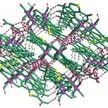 Researchers have demonstrated materials and techniques to achieve highly sensitive flexible biosensors integrated with metal-organic frameworks (MOFs) - essentially inorganic-organic hybrids that contain repeated metal ions connected with organic ligands. These high-throughput flexible devices can achieve highly specific and sensitive electrochemical detection and can be used to monitor neurotransmitters and nutrients in vivo.
Researchers have demonstrated materials and techniques to achieve highly sensitive flexible biosensors integrated with metal-organic frameworks (MOFs) - essentially inorganic-organic hybrids that contain repeated metal ions connected with organic ligands. These high-throughput flexible devices can achieve highly specific and sensitive electrochemical detection and can be used to monitor neurotransmitters and nutrients in vivo.
Jun 13th, 2018
 In new work, researchers explore inexpensive, biodegradable and daily-waste eggshell membrane as a novel bio-piezoelectric material for harvesting green energy. The uniqueness of our work lies in the novelty of directly utilizing natural eggshell membranes as efficient piezoelectric material. This simple, innovative approach could provide huge benefits for research in future energy science, especially with regard to in vivo biomedical applications.
In new work, researchers explore inexpensive, biodegradable and daily-waste eggshell membrane as a novel bio-piezoelectric material for harvesting green energy. The uniqueness of our work lies in the novelty of directly utilizing natural eggshell membranes as efficient piezoelectric material. This simple, innovative approach could provide huge benefits for research in future energy science, especially with regard to in vivo biomedical applications.
Jun 12th, 2018
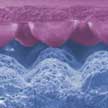 Mimicking the exciting skin structure and function, researchers have designed hierarchical nanoporous and interlocked micro ridge structured polymers with gradient stiffness. The gradient elastic modulus of interlocked and micro ridge structured polymers effectively transfers the external stress and induces the large frictional contact between two polymeric layers, which facilitates their use in self-powered triboelectric sensors. Furthermore, the additional nanoporous structures in the micro ridge structured polymers lead to the effective variation of both volume and gap distance between opposing surfaces without the need of bulky spacers, resulting in ultrathin and flexible triboelectric sensors for applications in wearable electronics.
Mimicking the exciting skin structure and function, researchers have designed hierarchical nanoporous and interlocked micro ridge structured polymers with gradient stiffness. The gradient elastic modulus of interlocked and micro ridge structured polymers effectively transfers the external stress and induces the large frictional contact between two polymeric layers, which facilitates their use in self-powered triboelectric sensors. Furthermore, the additional nanoporous structures in the micro ridge structured polymers lead to the effective variation of both volume and gap distance between opposing surfaces without the need of bulky spacers, resulting in ultrathin and flexible triboelectric sensors for applications in wearable electronics.
May 22nd, 2018
 Sepsis is the body's extreme response to an infection. It is life-threatening condition in which bacteria or fungi multiply in a patient's blood - often too fast for antibiotics to help. Without timely treatment, sepsis can rapidly cause tissue damage, organ failure, and death. A critical unmet need in combating sepsis is the lack of accurate early biomarkers that can alert clinicians to a potential life-threatening situation and allow them to take preventative action. In a new study, researchers report the development of a point-of-care platform for rapid sepsis detection, called IBS (integrated biosensor for sepsis).
Sepsis is the body's extreme response to an infection. It is life-threatening condition in which bacteria or fungi multiply in a patient's blood - often too fast for antibiotics to help. Without timely treatment, sepsis can rapidly cause tissue damage, organ failure, and death. A critical unmet need in combating sepsis is the lack of accurate early biomarkers that can alert clinicians to a potential life-threatening situation and allow them to take preventative action. In a new study, researchers report the development of a point-of-care platform for rapid sepsis detection, called IBS (integrated biosensor for sepsis).
Apr 12th, 2018
 Due to their fascinating optoelectronic properties, halide perovskites have attracted tremendous research interest as promising materials for photovoltaics, photodetectors, LEDs, and lasers. Researchers report report a strategy to synthesize perovskite nanocrystals using diblock copolymer micelles as a growth template. This work constitutes a new approach for synthesizing perovskite nanocrystals of controllable size and composition with vastly improved resistance to halide ion migration and environmentally induced degradation.
Due to their fascinating optoelectronic properties, halide perovskites have attracted tremendous research interest as promising materials for photovoltaics, photodetectors, LEDs, and lasers. Researchers report report a strategy to synthesize perovskite nanocrystals using diblock copolymer micelles as a growth template. This work constitutes a new approach for synthesizing perovskite nanocrystals of controllable size and composition with vastly improved resistance to halide ion migration and environmentally induced degradation.
 Subscribe to our Nanotechnology Spotlight feed
Subscribe to our Nanotechnology Spotlight feed





